What Is Ratio Analysis?
Ratio analysis is a form of financial analysis that is widely performed so that that the company or an organization can gather financial performance data quickly. The ratio analysis involves analyzing the financial statement of the company such as the balance sheet, income statement and the cash flow statement.
Many companies conduct ratio analysis to determine the financial performance and operation of their company, such its efficiency, liquidity, profitability analysis, and stability. If the ratio analysis is performed well, the result of it will be used to study whether the company is improving or deteriorating or experience both at the same time.
The Limitations of Ratio Analysis
Although the process and the result of the ratio analysis are important to the company, there are some limitations of ratio analysis that are sometimes neglected. It is important that the company should be aware of these limitations.
They are:
- Historical. The ratio analysis involves studying the information that is derived from historical results, the downside of the ratio analysis is that the same result will not be put to use in the future.
- Historical and current cost. One of the major limitation of the ratio analysis is that the information in the income statement is based on the current cost while some of the information in the balance sheet is derived from historical cost. This will result in odd ratio results.
- Inflation. The inflation can also hugely affect the result of the ratio analysis. it is because when the rate of the inflation change in any period, the figures in the ratio analysis will not be comparable across periods.
- Aggregation. The ratio analysis used all the information of financial statement that is aggregated in the past and this will result in a trend line that may not be comparable through the entire trend period.
The Purpose of Ratio Analysis
The main purpose of conducting the ratio analysis is that it helps the company evaluates the financial performance and the company’s stability. Companies use the ratio analysis to compare their company across different companies in the same sector to determine what level they are in the industry and how they can compete with the rest.
In addition to that, ratio analysis also helps the internal and external users to analyze the financial statement. One way they can do this is by examining the ratios that define the quantitative relationship between the income statement and the balance sheet.
Utility of the Ratio Analysis
Below are the uses of ratio analysis in different parties.
- Investors. The ratio analysis is useful to the investors as it will help them in evaluating the financial condition and status of the company and use profitability ratio analysis to determine the profitability position.
- Creditors. Creditors use the ratio analysis of the company to determine whether or not the company will be able to pay its debts at a specified time.
- Employees. Many employees are interested in the ratio analysis of the company because it’s their way they see if there are increases in wages, bonus, and other incentives.
- Management. The ratio simple analysis is also helpful to the management so that they can create a better decision, forecast financial and planning, and helps them increase the value of financial statements.










































